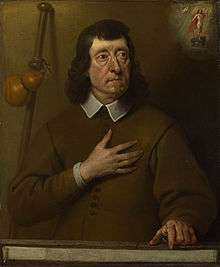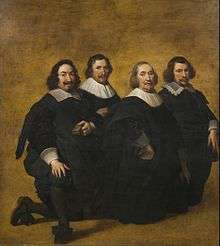Pieter van der Plas I

Pieter van der Plas I or Pieter van der¨Plas the Elder[1] (c. 1590 - c. 1661) was a painter active in Brussels in the first part of the 17th century. He is known for his individual and group portraits and genre paintings.[2]
Life
Little is known about the life of Pieter van der Plas. He is believed to have been born in Brussels or possibly in Haarlem. It is not known with whom he trained.[3] He was active in Brussels between 1610 and 1650, where he was a master of the local guild.[2][4] He is believed to have died in that city between 1650 and 1661.[2]
Pieter van der Plas has sometimes been confused with the artist referred to as P.V. Plas (also known as Pieter van de Plassen, P. van Dillen and the Monogrammist P.V.P.). This artist was active in Brussels in the period 1630 to 1650 and may have been Dutch. P.V. Plas was a still life painter who worked in the Flemish style.[5]
Work
Pieter van der Plas painted portraits of individuals as well as group portraits for the local guilds in Brussels.[2][6] The style of his paintings is similar to that of his younger contemporary painters Gonzales Coques and Gillis van Tilborch.[3]
Two of his portrait paintings show donors distributing bread and clothes to orphans while being looked upon by the Virgin and Child with St. Anne. One of these is signed jointly by Pieter van der Plas and the younger Brussels portrait painter Pieter Meert (The Museum of the Centre for Social Welfare of Brussels).[3]

In a large painting of an architect showing plans to a family in aristocratic attire against a landscape backdrop the artist animates the portrait of three generations of a family through his sense for psychology. The elder parents in black clothes are depicted on the left. Their daughter stands towards the middle, while her husband (an architect as shown by the plan on the table) and her son point towards her. At the extreme right stands the elderly couple's son. The servant filling his glass is pointing at him, as does his daughter with her small guitar. His wife sits in front of him. A small running dog at the bottom center symbolizes loyalty. In the background runs a small brook, probably the Maelbeek near Brussels.[3]
A Portrait of a man (National Gallery, London) used to be believed to be a portrait of John Milton.[3] A painting depicting a Falcon hunt (the National Gallery (Norway)) shows his interest in genre painting.[2]
References
- ↑ Also known as: 'Pieter van der Plaas' and 'Pieter van der Plassche'.
- 1 2 3 4 5 Pieter van der Plas (I) at the Netherlands Institute for Art History (in Dutch)
- 1 2 3 4 5 Pieter van der Plas the Elder, Falcon hunt at Jean Moust
- ↑ Reginald Howard Wilenski, Flemish Painters, 1430-1830, Volume 1, Viking Press, 1960, p. 248
- ↑ P.V. Plas at the Netherlands Institute for Art History (in Dutch)
- ↑ Pieter van der Plas, Vier mannen geknield (leden van het Brusselse zoutvisverkopersambacht?) (in Dutch)
External links
